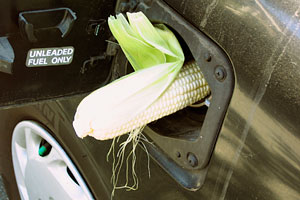 Is corn ethanol a poor fit for future U.S. liquid fuel needs? Biofuels have received a tremendous amount of publicity lately as an alternative to gasoline and diesel. An ethanol economy based on sugarcane has helped to boost Brazil into the limelight, raising standards of living and perhaps even contributing to the country’s recent successful bid at the 2016 Olympic games. In the U.S. prospects of corn-based ethanol have piqued the interest of agriculture and oil companies alike. Such unbridled excitement has also revealed dramatic downsides. Brazilian affluence comes at the price of biodiversity as swaths of rainforest are sacrificed to plant new crop fields. Increased American deand for corn was a measurable contributing factor to the recent world food crisis.
Is corn ethanol a poor fit for future U.S. liquid fuel needs? Biofuels have received a tremendous amount of publicity lately as an alternative to gasoline and diesel. An ethanol economy based on sugarcane has helped to boost Brazil into the limelight, raising standards of living and perhaps even contributing to the country’s recent successful bid at the 2016 Olympic games. In the U.S. prospects of corn-based ethanol have piqued the interest of agriculture and oil companies alike. Such unbridled excitement has also revealed dramatic downsides. Brazilian affluence comes at the price of biodiversity as swaths of rainforest are sacrificed to plant new crop fields. Increased American deand for corn was a measurable contributing factor to the recent world food crisis.
The timing, then, was quite appropriate for a panel discussion last week organized by the Friends of Berkeley Lab at the Berkeley Repertory Theatre. Titled “Hope or Hype: What’s Next For Biofuels?” the event, hosted by KTVU’s John Fowler, featured a panel with Jay Keasling, Susanna Green Tringe, and Jim Bristow, three scientists exploring the role that synthetic biology might play in fabricating a better fuel for tomorrow’s autos. The evening consisted mainly of two themes: the relative limits of both crude oil and corn-based ethanol, and an outline of research being pursued to make new ideas practical.
Fossil fuels are unsustainable, a point that saturates public rhetoric each election cycle to the point of ad nauseum. It might be slightly more surprising to learn, however, that fuel based on ethanol (the alcohol found in all common beers, wines, and liquors) may be as bad for global warming as gasoline, perhaps even be worse. When extracted from corn, considerable energy is lost on fertilizers. If that energy was generated using a coal plant, global warming is still a problem. Additionally, ethanol is an unwieldy fuel. It is corrosive, for example, and therefore must be trucked, rather than piped, from one location to another. “I like to say that ethanol is for drinking, not for driving,” Keasling joked as he explained these faults.
The push in the American science community, then, tends to be away from corn-based ethanol and toward something called cellulosic biomass (Editor's Note: see our QUEST video "Beyond Biofuels" for more information). The idea is to make fuels not from corn, but rather from corn stover—plant leftovers after the crop has already been harvested. Alternatively, almost any other organic material ranging from wheat stover to sorghum to garbage could be used if the proper techniques are developed.
There are considerable scientific challenges. Much of the material we might like to use as fuel is tough and woody. Scientists have yet to figure out a satisfactory method for breaking this down, and a great deal of gene-sequencing effort is currently underway with the aim figuring this out. There are also challenges in terms of deciding what product will be generated from these woody materials. At least one idea is to genetically engineer an organism that can transform organic matter not into ethanol, but rather into something more amenable to transport and carbon neutrality.
